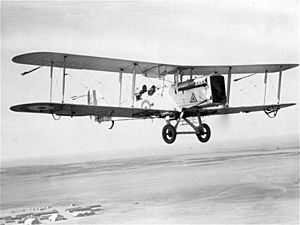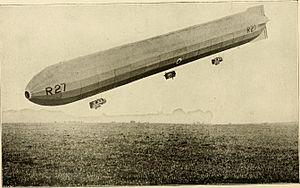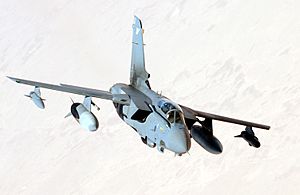History of the Royal Air Force facts for kids
The Royal Air Force (RAF) is the air force of the United Kingdom. It has a long and exciting history, spanning over a hundred years of British military flying!
The RAF was created on April 1, 1918, near the end of World War I. It was formed by joining two older flying groups: the Royal Flying Corps (from the army) and the Royal Naval Air Service (from the navy). After World War I, the RAF became much smaller. Between the two World Wars, it helped keep peace in different parts of the British Empire.
The RAF grew very quickly before and during Second World War. During this war, it defended Great Britain from air attacks, bombed targets in Germany, and supported the British Army all over the world.
During the Cold War, the RAF's main job was to protect Europe from a possible attack by the Soviet Union. For many years, it even held Britain's nuclear weapons. After the Cold War ended, the RAF took part in many big operations, like the Gulf War, the Kosovo War, the War in Afghanistan, and the Iraq War.
Contents
How the RAF Began and Grew
Starting the RAF
The RAF is the world's oldest independent air force. This means it was the first air force to be separate from the army or navy. It was formed on April 1, 1918, by combining the Royal Flying Corps and the Royal Naval Air Service. A new government department called the Air Ministry was set up to control it.
The decision to create a separate air force came from lessons learned in World War I. This was the first war where air power played a big role. To show that the new service combined both army and navy flying, many officer ranks were given naval names, like flight lieutenant and wing commander.
When it was created, the RAF was the most powerful air force in the world! It had over 20,000 aircraft and more than 300,000 people, including the Women's Royal Air Force. After the war, a memorial was built in London to remember the RAF's service.
Keeping Peace in the Empire
After World War I, the RAF took on the job of keeping peace in the British Empire from the air. People believed that using air power would be cheaper and more effective than using soldiers on the ground to control large areas.
This idea was first used in 1920 when the RAF helped defeat rebels in Somaliland. In 1921, the RAF became responsible for all British forces in Iraq, helping to manage tribal unrest. The RAF also served in Afghanistan in 1925 and again in 1928, when they helped rescue British and European staff during a civil war.
RAF Activities in Britain
During the years between the World Wars, the RAF had to prove it was needed. Some people wondered if a separate air force was necessary, especially during peacetime. To avoid being disbanded, the RAF worked hard to stay in the public eye. They did this through events like the yearly Hendon Air Show and by supporting a team in the Schneider Trophy air races.
In 1936, the RAF was reorganized, creating important commands like RAF Fighter Command, RAF Bomber Command, and RAF Coastal Command.
At first, when the RAF was formed, it took control of all aircraft and flying personnel from the Navy. However, the Navy still managed its aircraft carriers. Over time, the Navy wanted its own air force back. After much discussion, in 1937, the Admiralty (the Navy's leadership) took back control of naval aviation. By 1939, it was fully under Navy control and renamed the Air Branch of the Royal Navy, which is now known as the Fleet Air Arm.
Strategic Bombing Ideas
The RAF developed the idea of strategic bombing after Germany bombed Britain during World War I. This meant using planes to bomb important targets far behind enemy lines. This idea led to the building of long-range bombers and became a key part of the RAF's strategy in World War II.
World War II (1939–1945)
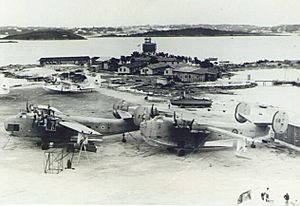
The RAF grew very quickly after the war against Nazi Germany began in 1939. Many aircrews from British Commonwealth countries like Canada and Australia were trained and joined the RAF. Thousands of people from other countries who had fled German-occupied Europe also joined.
A very important time for the RAF was during the Battle of Britain in the summer of 1940. The RAF fought off the German air force, the Luftwaffe, in a long and difficult air battle. This battle helped stop Germany's plans to invade the United Kingdom. Prime Minister Winston Churchill famously said about the RAF fighter pilots, "Never in the field of human conflict was so much owed by so many to so few."
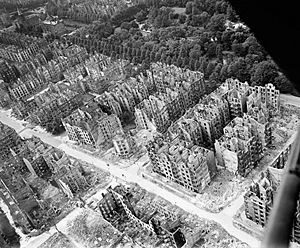
The RAF's main effort during the war was a huge bombing campaign against Germany. From 1942, RAF Bomber Command could launch large night raids, sometimes with up to 1,000 aircraft. Many of these were heavy four-engine bombers like the Handley-Page Halifax and the Avro Lancaster. Famous raids included the first 1,000-bomber raid on Cologne, the 'Dambusters' raids, and the destruction of Hamburg. The faster, lighter de Havilland Mosquito was used for special tactical raids and as a night-fighter.
Cold War (1947–1990)
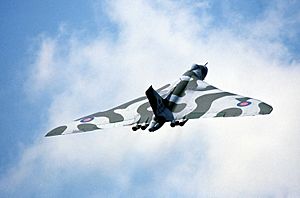
After World War II, the RAF changed as new jet fighters and bombers were developed. The RAF's first big action in the Cold War was helping with the Berlin Airlift in 1948-1949. This operation, called Plainfare, delivered supplies to West Berlin when the Soviets blocked all land routes.
The RAF's main job during the Cold War was to defend Western Europe from a possible attack by the Soviet Union. Many RAF squadrons were based in West Germany. As the British Empire became smaller, the RAF's global operations were reduced.
Even so, the RAF fought in many smaller conflicts during the Cold War. From 1948 to 1960, the RAF took part in Operation Firedog against terrorists in Malaya. They also had a small role in the Korean War and helped with anti-rebel operations in Kenya from 1953 to 1956. In 1956, the RAF played a big part in the Suez Crisis, flying aircraft from bases in Cyprus and Malta. They also used aircraft during the Konfrontasi against Indonesia in the early 1960s.
Belize (1975–1994)
Belize (which used to be called British Honduras) was threatened by Guatemala for many years. In 1975, when talks broke down, Guatemala moved troops close to the border. The British sent more soldiers and RAF helicopters and Harrier jets to Belize to help defend the border. These aircraft stayed in Belize for many years, acting as a deterrent and helping with jungle warfare training. Guatemala finally recognized Belize in 1991, and the RAF aircraft left in 1993 and 1994.
Falklands War

The Falklands War in 1982 was mostly fought by the Navy and Army because the islands were so far away. However, RAF aircraft were still very important. They were based on RAF Ascension Island in the mid-Atlantic and on the Navy's aircraft carriers. RAF pilots also flew Royal Navy Sea Harriers and shot down five Argentine aircraft.
The most famous RAF missions were the "Black Buck" raids, where Avro Vulcan bombers flew very long distances from Ascension Island to bomb targets in the Falklands. The RAF also used helicopters, Harrier GR3s from HMS Hermes, and Nimrod MR2 patrol planes to scan the South Atlantic. Their tanker and transport planes also helped with the huge task of moving supplies for the war.
After the war, the RAF stayed in the South Atlantic to defend the Falkland Islands. A new airfield, RAF Mount Pleasant, was built in 1984 to provide a base for fighter and transport planes.
1990–2000
Gulf War
Before the Gulf War began in 1991, RAF fighter jets were based in Saudi Arabia and Kuwait. Over 100 RAF aircraft took part in the main air campaign. This war was a big moment for the RAF because it was the first time they used precision-guided weapons (smart bombs) in large numbers. After the war, the RAF helped enforce no-fly zones over Iraq and took part in bombing Iraq in 1998.
Balkans
In 1993, RAF Tornado F3s and AWACS aircraft helped with Operation Deny Flight, a NATO operation to control airspace over Bosnia and Herzegovina. This operation continued until 1995.
The Kosovo War in 1999 was the first time the RAF fought over Europe since World War II. During the bombing of Yugoslavia, the RAF used Harrier GR7 and Tornado ground attack jets, along with many support aircraft.
2001–Present
"War on Terror"
As part of Britain's contribution to the 2001 invasion of Afghanistan, the RAF provided support with air-to-air refuelling planes and reconnaissance aircraft. Chinook helicopters helped move troops and supplies. From late 2004, RAF Harriers and later Tornados were based in Afghanistan, providing close air support against the Taliban.
The 2003 invasion of Iraq involved a large RAF deployment to the Gulf. RAF strike aircraft took part, and the RAF also hosted US B-52 bombers. Sadly, the RAF lost a Tornado jet to friendly fire from a US Patriot missile and a Hercules transport plane to ground fire. After the invasion, the RAF was based at Basra in southern Iraq, operating Merlin, Puma, and Chinook helicopters.
In 2013, the RAF supported a French operation against militants in Mali, transporting French vehicles and providing surveillance with a Sentinel R1 aircraft. In 2014, the RAF helped search for kidnapped schoolgirls in Nigeria as part of Operation Turus.
The RAF is currently involved in the fight against ISIL (also known as ISIS), called Operation Shader. Flying from RAF bases in Cyprus, they have destroyed many ISIL targets, delivered humanitarian aid in Iraq, and carried out surveillance missions in Syria.
In 2015, RAF Pumas were sent to Afghanistan to support NATO forces training the Afghan Security forces. In 2018, RAF Chinook helicopters were deployed to Mali to support a French counter-terrorist operation.
Libyan Civil War
In 2011, the RAF played a big part in the NATO intervention in Libya. This operation, called Ellamy, involved many types of RAF aircraft, including Typhoon fighters, Tornado GR4 strike aircraft, AWACS surveillance planes, and air-to-air refuelling tankers.
Other Operations and Activities
In 2004, RAF Tornado F.3s were sent to the Baltic States to help with NATO's Baltic Air Policing operation. In 2005, support and transport aircraft were sent to South East Asia to provide aid after the 2004 Indian Ocean earthquake disaster.
The RAF celebrated its 90th anniversary on April 1, 2008, with a flypast of Red Arrows and Typhoons over London. The RAF also celebrated its 100th anniversary on April 1, 2018, with many special events throughout the year.
The Hercules transport plane, known as the Hercules C4 and C5 in RAF service, was used for shorter-range airlifts. These planes were based at RAF Brize Norton. The Hercules fleet was retired from RAF service on June 30, 2023.
Number of Personnel
After World War I, the RAF became much smaller. It only grew significantly again just before World War II. At its peak during World War II, there were over one million RAF servicemen. Since then, the number of people in the RAF has steadily decreased.
| Year | 1918 | 1951 | 1975 | 1985 | 1993 | 1997 | 2005/2006 | 2009 | 2011 | 2012 | 2015 |
|---|---|---|---|---|---|---|---|---|---|---|---|
| Regular | 316,170 | 148,900 | 95,000 | 93,400 | 80,900 | 56,900 | 48,700 | 43,800 | 40,090 | 38,930 | 31,830 |
| National Service | N/A | 88,900 | N/A | N/A | N/A | N/A | N/A | N/A | N/A | N/A | N/A |
| Regular Reserve | N/A | N/K | N/K | 29,800 | 46,100 | 45,400 | 35,000 | 35,160 | 6,900 | 6,660 | 2,220 |
| Volunteer Reserve | N/A | 18,100 | N/K | 1,200 | 1,800 | 1,400 | 1,400 | 1,480 | 1,360 | 1,360 |
More to Explore
- List of Royal Air Force operations
- List of all aircraft current and former of the United Kingdom
- Future of the Royal Air Force
- Royal Air Force Museum London and Royal Air Force Museum Cosford, museums all about the history of flying and the Royal Air Force.


